History and Biblical SignificancePergamum, or Pergamos, or Pergamon, now Bergama, was a major city of Mysia, in Asia Minor, in what is today Turkey. Located about 15 miles / 24 kilometers inland from The Aegean Sea, it was the capital for the Pergamenian kings until about 133 BC when it came under Roman control. The Romans, who were yet to attain their greatest extent of territorial greatness, made it the central city of their new province of "Asia." In 29 BC a temple for the worship of Caesar Augustus (the Roman emperor who later called that famous census that resulted in Jesus Christ being born in Bethlehem i.e. Luke 2:1) was erected in Pergamum, however worship of him and subsequent emperors was long rivaled there by the cult of the pagan god Zeus, the symbol of whom was a serpent. Pergamum's throne-like altar of Zeus, that some have speculated was the symbolic "Satan's throne" reference in Revelation 2:13, is now in the Pergamon Museum in Berlin. Parchment, an ancient writing material made from the processed skins of animals, most often that of calves, sheep and goats, was invented in Pergamum to free the great library there from dependence upon imported papyrus, mainly from Egypt. Pergamum is mentioned in The Bible as one of the "seven churches of Asia." Christians there were rebuked for deviating from the truth that they once held by following the idolatrous and immoral teachings of Balaam and the Nicolaitans. Antipas, a true and faithful Christian of whom little else is known, was martyred in Pergamum. "And to the angel of the church in Pergamum write: 'The words of Him Who has the sharp two-edged sword. 'I know where you dwell, where Satan's throne is; you hold fast My Name and you did not deny My faith even in the days of Antipas my witness, my faithful one, who was killed among you, where Satan dwells.' But I have a few things against you: you have some there who hold the teaching of Balaam, who taught Balak to put a stumbling block before the sons of Israel, that they might eat food sacrificed to idols and practice immorality. So you also have some who hold the teaching of the Nicolaitans. Repent then. If not, I will come to you soon and war against them with the sword of My mouth." (Revelation 2:12-16 RSV) |
 As we approached Pergamum, we could see ruins on the hill.
As we approached Pergamum, we could see ruins on the hill.
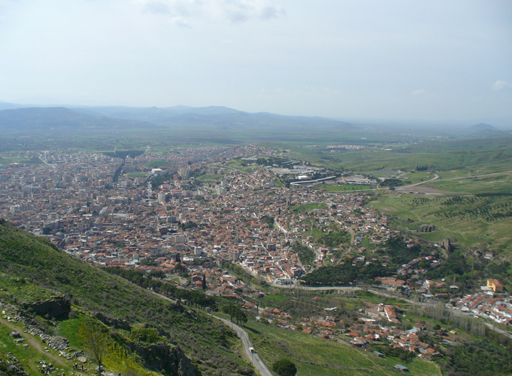 Our bus took us almost to the top and we climbed a bit further for a view of the road we had come up and the city of Bergama below.
Our bus took us almost to the top and we climbed a bit further for a view of the road we had come up and the city of Bergama below.
 Some of the remains of the city wall.
Some of the remains of the city wall.
 A stoa outside the Sanctuary of Athena.
A stoa outside the Sanctuary of Athena.
 This is thought to be part of the building which housed the library. At the time it was the second largest library in the world, second only to the one in Alexandria. As noted above, because this library was threatening Alexandria, Egypt stopped sending papyrus to Pergamum so they had to look for other writing materials. They then began using parchment, made from the hides of goats and sheep.
This is thought to be part of the building which housed the library. At the time it was the second largest library in the world, second only to the one in Alexandria. As noted above, because this library was threatening Alexandria, Egypt stopped sending papyrus to Pergamum so they had to look for other writing materials. They then began using parchment, made from the hides of goats and sheep.
 The entrance to the courtyard of the temple of Trajan, begun during the reign of Trajan (98-117 AD) and completed in the reign of Hadrian (117-138 AD).
The entrance to the courtyard of the temple of Trajan, begun during the reign of Trajan (98-117 AD) and completed in the reign of Hadrian (117-138 AD).
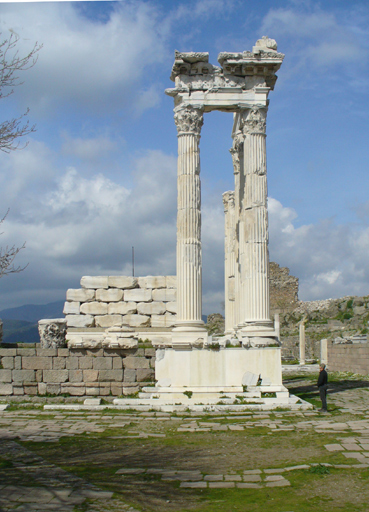 A few of the remining columns of the Temple of Trajan. These columns are over 40 feet high, with nine columns lining the two longer sides and six on the shorter sides. The temple was over 105 feet long and 65 feet wide.
A few of the remining columns of the Temple of Trajan. These columns are over 40 feet high, with nine columns lining the two longer sides and six on the shorter sides. The temple was over 105 feet long and 65 feet wide.
 The columns were Corinthian and exquisitely carved.
The columns were Corinthian and exquisitely carved.
 Another view of the pillars of the Temple of Trajan which shows the level of the terrace on which it was built. To support this terrace, there are vaults below and we can see the tops of the arches of those vaults at the bottom of this photo.
Another view of the pillars of the Temple of Trajan which shows the level of the terrace on which it was built. To support this terrace, there are vaults below and we can see the tops of the arches of those vaults at the bottom of this photo.
 Here are some of the buttresses which also support the terrace.
Here are some of the buttresses which also support the terrace.
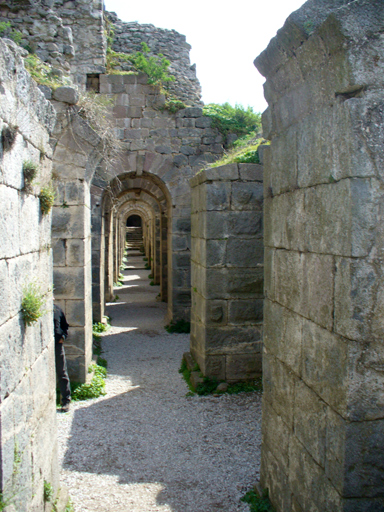 We can get below to see these buttresses.
We can get below to see these buttresses.
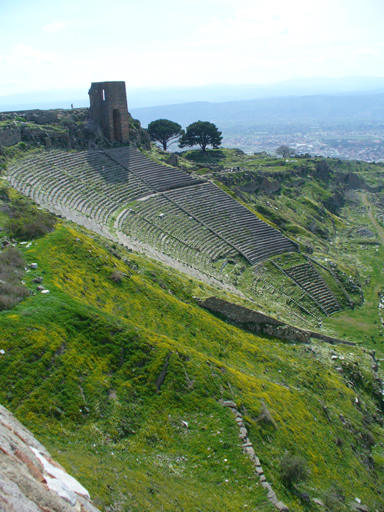 We walk to the edge of the terrace where we get a good view of the theater, originally built during the 3rd century BC, modified by the Romans. The theater has 80 rows of seats, divided into three sections, with a seating capacity of about 10,000 persons.
We walk to the edge of the terrace where we get a good view of the theater, originally built during the 3rd century BC, modified by the Romans. The theater has 80 rows of seats, divided into three sections, with a seating capacity of about 10,000 persons.
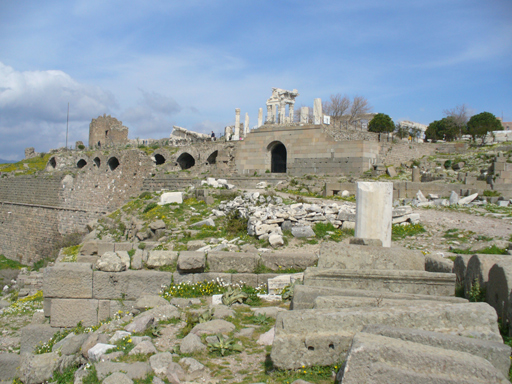 From the top of the theater we have an excellent view of the vaults supporting the terrace.
From the top of the theater we have an excellent view of the vaults supporting the terrace.
 Some of us walk partway down the steps of the theater.
Some of us walk partway down the steps of the theater.
 From there we have a view of the Temple of Dionysius below.
From there we have a view of the Temple of Dionysius below.
 A closeup of the Temple of Dionysius originally built in the 2nd century BC and rebuilt by the Roman emperor Caracalla in marble in the early 3rd century AD.
A closeup of the Temple of Dionysius originally built in the 2nd century BC and rebuilt by the Roman emperor Caracalla in marble in the early 3rd century AD.
 The base of the open-air altar dedicated to Zeus, also called the Pergamon (Pergamum) Altar, which has been reconstructed in the Pergamon Museum in Berlin. See this Wikipedia article on the Pergamon Altar. This altar appears to be mentioned in Revelation 2:12-13: "In Pergamos where Satan's Throne is".
The base of the open-air altar dedicated to Zeus, also called the Pergamon (Pergamum) Altar, which has been reconstructed in the Pergamon Museum in Berlin. See this Wikipedia article on the Pergamon Altar. This altar appears to be mentioned in Revelation 2:12-13: "In Pergamos where Satan's Throne is".
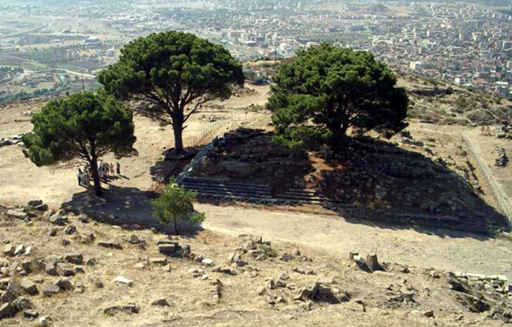 Another view of the remains from the article mentioned above.
Another view of the remains from the article mentioned above.

A drawing of a restored view of Pergamum. The altar of Zeus is at the right, with the smoke ascending from it. To its left and above it is the Temple of Athena and to the far left is the Temple of Trajan.
We were able to see the altar of Zeus in the Pergamon Museum in Berlin in a trip there in 2012. It had been excavated from this site in the 1880's shipped to Berlin, and installed the Pergamon museum there, along with the famous Ishtar Gate of Babylon and other antiquities.
Our next stop is Ancient Troy.
